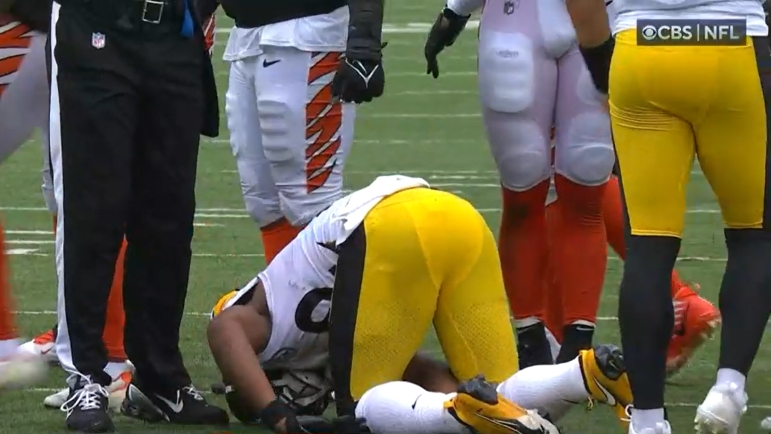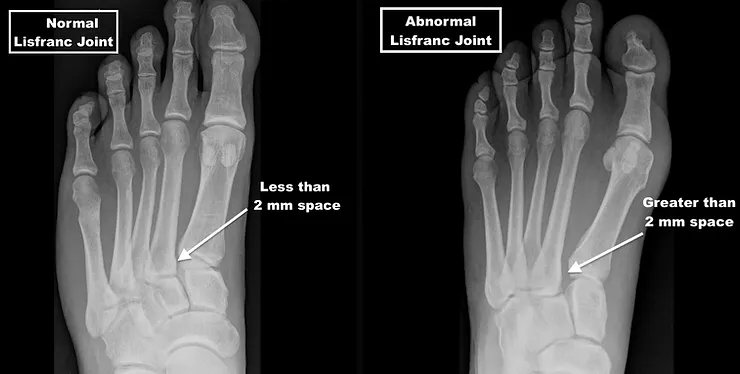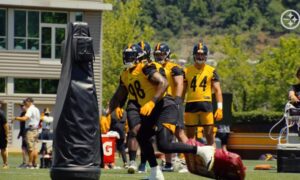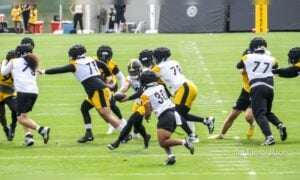Najee Harris entered the season opener against the Cincinnati Bengals with a clean bill of health. After getting his foot stepped on during practice on the first day of training camp, Harris missed most of the preseason. He finally took snaps in the third and final preseason game. Afterwards, he revealed that he had been dealing with a Lisfranc injury and I explained the injury here.
With less than two minutes left in regulation, Harris was tackled with his left foot twisting awkwardly. He appeared to be in significant pain but was able to limp off the field on his own. He did not return to the game during the OT period and was seen leaving the locker room in a boot following the team’s hard fought win. Several hours later, reports surfaced that the team did not consider the injury to be serious. This was confirmed by Ian Rapoport the following day, who described it as a tweak of the original Lisfranc injury. Yesterday, Adam Schefter reported that Harris’s tests came back negative and he should be good to go when the Patriots come to Pittsburgh on Sunday. Harris himself doubled down on that during a radio interview, stating that he expected to practice this week and would be ready to play.
Maybe. But maybe not. In his weekly Tuesday press conference, Head Coach Mike Tomlin took a more conservative approach, stating that the young player’s enthusiasm is appreciated but he would have to practice and prove his readiness.
So what does this latest injury mean for Najee for this week and the rest of the season?
Based on the choice to treat Harris’s Lisfranc injury without surgery, it is safe to assume that he had a Grade 1 injury with less than 2 mm of spacing between the bones of the joint, meaning that there was no displacement of the bone.
The standard treatment is six weeks in a boot for patients who are able to avoid surgical repair. Surprisingly, Harris skipped that step, seen on the sidelines in Latrobe either in sneakers or even bare feet. That suggests that Harris was able to bear weight without pain, another indication of a mild injury. Another positive sign was his ability to play in a preseason game only four weeks after the injury. Considering all of that, it is likely that the original injury was very mild and it was just bad luck that his left foot got twisted on Sunday. The question now is whether he will suffer a setback in his recovery and miss more time.
There is almost no data regarding recurrent or reaggravation of Lisfranc injuries in the medical literature, particularly for those patients who are treated non-operatively. A 2019 meta-analysis published in the Journal of Foot and Ankle looked at 366 patients in 17 published studies that specifically looked at return rates and time to return to sport following Lisfranc injuries. For athletes with undisplaced (Stage 1) injuries managed non-operatively, the return rate was 100% and the return time was 4 weeks. For athletes with stable minimally-displaced (Stage 2, 2-5 mm spacing of the joint) managed without surgery, return rate was also 100% but return time was longer at 9.1 weeks. The key in these studies? The athletes were fully recovered prior to resuming play.
Harris is a passionate competitor and it is no surprise that he is campaigning to start this Sunday. He is also the star running back on a team that very badly needs to find a way to rediscover a rushing attack. Putting him on the field when his foot is less than 100% might aggravate the sprain and leave the second year player with a lingering injury that limits his push-off and burst for the rest of the season, limiting his effectiveness. While neither Najee Harris nor Mike Tomlin live in their fears, it might be wise to keep Harris on the sideline this week and allow him to recover so that he can perform at the level of his true potential.
“Melanie H. Friedlander, M.D., F.A.C.S. is a doctor at Association of South Bay Surgeons in Torrance, California. Dr. Friedlander enjoys all aspects of general surgery, but her primary areas of focus are breast surgery and advanced laparoscopic surgery. She recently adopted an advanced, minimally invasive technique that reduces scar size in thyroid surgery. Dr. Friedlander is a member of the Society of American Gastrointestinal Endoscopic Surgeons (SAGES) and the Society of Laparoscopic Surgeons. She developed and published many scientific studies in highly esteemed medical journals.”









